|
Bull Riding
Equipment
Bull Rope
The main piece of equipment used in riding a bull is
the bull rope It is usually a poly rope braided with a handhold in the
center. The handhold is reinforced with leather lacing to make it
stiff, and to stop it from twisting, or rolling over. If the rope
rolls over, it is dangerous because the rider may become hung up in
his rope. On one end of the rope is a loop. The tail of the rope is
dropped under the bull, and pulled back through the loop like a slip
knot. The rider then warms up the rosin on his rope to make it sticky,
and wraps the tail around the back of his hand and back across the
palm.
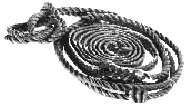 There are
several different kinds of bull rope, but one major difference is the
plait. This has to do with how many strands the bull rope was braided
with, and how tightly the rope is braided. The most common plaits are
5, 7, and 9. A five plait is a very soft, mushy braid, where a nine
plait is very hard and tight. The seven plait falls somewhere in
between. Some ropes are available with the handhold and the tail
braided differently. The handhold could be braided as a 7 plait, and
the tail a five plait. There are
several different kinds of bull rope, but one major difference is the
plait. This has to do with how many strands the bull rope was braided
with, and how tightly the rope is braided. The most common plaits are
5, 7, and 9. A five plait is a very soft, mushy braid, where a nine
plait is very hard and tight. The seven plait falls somewhere in
between. Some ropes are available with the handhold and the tail
braided differently. The handhold could be braided as a 7 plait, and
the tail a five plait.
 Bells Bells
A bell attached to the bull rope is required by
virtually every rodeo association in the US. Not only do the bells add
sound and action to a bull ride, but their weight pulls the rope off
after the rider dismounts. This speeds up the rodeo and makes life
easier for the workers behind the chutes stripping bulls. The most
common bells are made of a tinny copper material that will crush if a
bull steps on them, but can easily be pounded back out. Other heavier
bells are made of steel, but are not popular with stock contractors or
clowns. These bells may lame a bull if stepped on, or injure a person
because of their weight. Sometimes these bells are called clown
killers.
Gloves
 A
leather glove usually made of buckskin or steerhide is used in bull
riding. Some riders prefer a thinner glove which will give them more
feel, while others prefer a tougher glove that will last longer and
offer more protection. The glove is usually strapped on with a Velcro
strap around the wrist, or tied on with a latigo thong. A
leather glove usually made of buckskin or steerhide is used in bull
riding. Some riders prefer a thinner glove which will give them more
feel, while others prefer a tougher glove that will last longer and
offer more protection. The glove is usually strapped on with a Velcro
strap around the wrist, or tied on with a latigo thong.
The bull rider uses either black or amber rosin and
rubs it into the palm of his glove, and rosins up his rope by drawing
his gloved hand across the tail and the handhold of the rope. This
makes the rope sticky, giving him a better grip when he rides. Amber
rosin is currently the most popular, but black rosin is often used.
One disadvantage to black rosin is that it tends to be gummy and can
make a mess out of a rope. Glycerin, commonly purchased as saddle
soap, is also used by some riders before rosining their ropes. When
glycerin is used the rope becomes extra sticky, but it must be used in
moderation because too much will result in a hang up.
 Rope
Pads Rope
Pads
A rope pad is a piece of foam or sheepskin that is
placed under the handhold to protect the rider's knuckles from the
bull's backbone. Many rope pads are covered with suede or leather to
make them more durable. Usually they tie on with latigo thongs or
Velcro straps.
Spurs
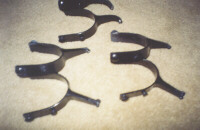 Bull
spurs are primarily designed to grab the bulls hide, anchoring the
riders feet and aiding him in his ride. Their second purpose is to
spur the bull, resulting in a higher score for the rider and probably
more action out of the animal. Bull riding spurs have fixed rowels,
that is, they do not spin. Usually the rowels are locked by a cotter
pin or bolt run through the shank of the spur between the teeth of the
rowel. Bull
spurs are primarily designed to grab the bulls hide, anchoring the
riders feet and aiding him in his ride. Their second purpose is to
spur the bull, resulting in a higher score for the rider and probably
more action out of the animal. Bull riding spurs have fixed rowels,
that is, they do not spin. Usually the rowels are locked by a cotter
pin or bolt run through the shank of the spur between the teeth of the
rowel.
Bull riding rowels are never sharp and riders are
careful to keep the rowels dulled to prevent cutting the animals. Not
only is cutting a bull likely to make a stock contractor unhappy, it
is also of negative consequence to the rider. If a rowel is so sharp
that it cuts, it provides little value to the bull rider when trying
to plant his feet.
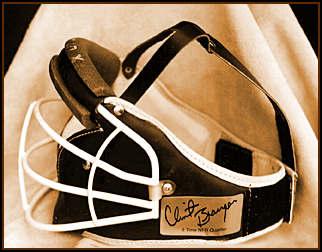 Face
Mask Face
Mask
One of the most things a rider is worried about is his
face. After all, their looks may be all they've got going for them!
Besides no sponsor wants an ugly face on his big posters. With all
kidding a side the bull rider really does need to protect his face.
Like any other part of the body this too can hurt. No matter how hard
your head may be a hit by a 1200 pound bull will do the trick. Just
look at how long Tuff Hedeman was in the OR after his run in with
Bodacious.
That is why several bull riders have started using
face masks. This mask is to protect the face from impact with the
bull, chute, or ground. There are several types. Some riders use
hockey mask while others use the Ride All.
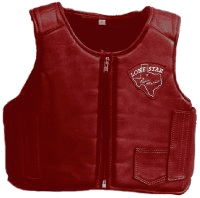 Vest Vest
The vest serves as a protector for the bull rider. It
will fit snug, but still give the rider the freedom of movement.
Should the bull hook or step on the contestant the vest will take most
of the impact. This is one of the most important pieces of equipment
that the bull rider can invest in.
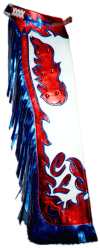 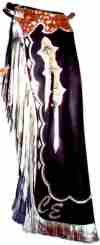 Chaps Chaps
No matter if you call them chaps ( pronounced as shaps)
or if you call them leggin's they look very attractive. They were
meant to protect the clothes. They also serve the purpose of helping
the rider from sliding on the back of the bull.
Many bull riders have made theirs very extravagant to
have the look of a man with money. Believe me some of this can cost
MONEY, with a Capital M.
|

